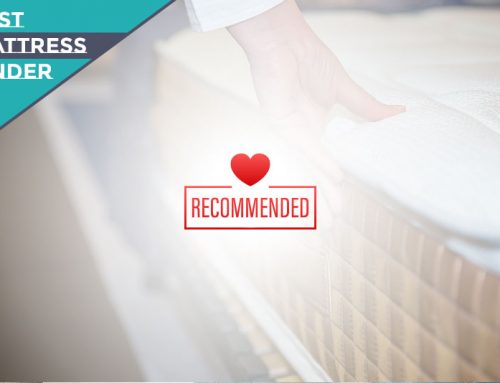How to choose the best innerspring mattress
Innerspring sounds like it’s a cool move in gymnastics but it’s actually a pretty intriguing type of mattress to consider choosing. Innerspring mattresses are some of the oldest types of beds on the market. They’ve been around for a long time and have been modified throughout the years but they still hold up pretty well as one of the most popular types of mattresses in the bed world.

Innerspring mattresses are made from metal coils and a kind of comfort layer on top. Mostly because nobody wants to sleep exclusively on metal coils. The top layers are usually made out of synthetic or natural foam.
Innerspring mattresses are probably the types of beds that millennials are most familiar with from their childhood. They were immensely popular in the 1980s and 90s and are still made from the same type of mold in the 2020s: a steady foundation that’s made out of a solid base or spaced out slats.
Innerspring beds are the type of beds that you can feel the coils through, especially on older models. If you have memories as a kid of jumping on a bed and hearing that springy sound, it was probably an innerspring mattress. Modern innersprings have been updated with newfound technologies in beds and we’re going to help you decide on how to choose innerspring mattresses.
The benefits of innerspring mattresses are pretty vast. For starters, they’re very affordable for the everyday sleeper. If you’re looking for a natural mattress but can't afford an all-latex one, innersprings should be on your radar.
Since a lot of people grew up sleeping on one (or bouncing on your parents’) innerspring mattresses have a phenomenal nostalgia factor that resonates well with a lot of sleepers. Traditionally, innerspring mattresses give off a lot of bounce and they tend to be very soft.
Because natural latex mattresses are most-often sourced overseas, innerspring mattresses are a much more cost-effective choice when it comes to mattresses.
Memory foams are made from a type of chemical called polyurethane foam that is known for its outstanding quality to provide pressure relief. But, since it’s made from a synthetic compound, memory foam mattresses are known to sleep very hot and trap body heat within the mattress. Because memory foam mattresses contour your body and form around your muscles and skin, it can get real hot and not provide enough air circulation. Innerspring mattresses don’t have that problem. Because they’re made out of metal coils, innerspring beds tend to breath very well as metal is a great conductor for heat. Without using chemicals to create cooling properties, innerspring mattresses are naturally cool sleeping, ideal for people who are tossing and turning while sleeping hot and sweating throughout the night.
[amazon box="B07DN6H6CG"]
[amazon box="B0134FXZ40"]
[amazon box="B0774QBC52"]
[amazon box="B073VMTFCC"]
[amazon box="B011397784"]
There are two common types of innerspring mattresses: bonnell springs and pocketed coils.
Bonnell springs are shaped like an hourglass and are interlocked making the coils incredibly durable. Remember those mattresses you were jumping on as a kid? They were most probably bonnell springs and that mattress is probably still even effective today. With bonnell springs, the lower the gauge of coils, the more firm the springs. A firm spring will make for a harder mattress and won’t sleep as hard. It’s ideal for sleepers who are looking for additional support, especially if they have some muscle or joint pains and aches.
Pocketed coils are placed individually and rounded. They tend to be more favourable over bonnell springs for sleepers looking for even more body pain relief. They also have much less motion transfer than bonnell spring mattresses. If you’re sharing a bed with your partner (or kids and pets) and you want a mattress that has very little motion transfer, the pocketed coil innerspring mattresses should be your go-to. If you or your partner wakes up early and you don’t want to disturb them, pocketed coils are a wise choice. One sleeper can get up and get going and the idea is that the other person doesn’t feel the bed moving. Because let’s be honest, there’s not many better feelings than being able to go back to sleep after your partner wakes up early for work. The classic “have a good day, Hunny” as you get to dive back into bed for a few more hours.
When choosing innerspring mattresses, comfort layers are a major part. You’re going to want to choose a layer that offers pressure relief and support at the same time. It’s always valuable to consider your weight and sleeping patterns. If you sleep on your stomach, getting a firmer mattress will help you, in the long run, to avoid sinking into the bed and arching your back too much.
Before you make your final decision, it’s important to read user reviews online to see what like-minded sleepers think about innersprings. You’ll also want to create a balance between the retail shop, compare prices, and feel free to comment on blogs and videos and ask around. User comments, as opposed to mattress shops, give the absolute truth and unbiased opinions. There are thousands of reviews out there and it’s an ideal platform to be able to help you choose your innerspring mattress.
When it comes to your budget, if you look around enough, you should be able to find a perfectly good, brand new innerspring mattress for less than $1000. Higher-end brands will run you about $2,000 and remember that budget shouldn’t matter too much when you have comfort in mind. An extra $1000 now will hurt in the short-term but if it’s for a few years of added comfort, you really can’t go wrong.
With that said, spending close to a grand on a mattress is expensive but not as much if you’d choose hybrid, latex, or memory foam mattresses. Besides, you can’t really put a price on nostalgia. But yes, your kids will also jump on your bed. It’s all worth it.





